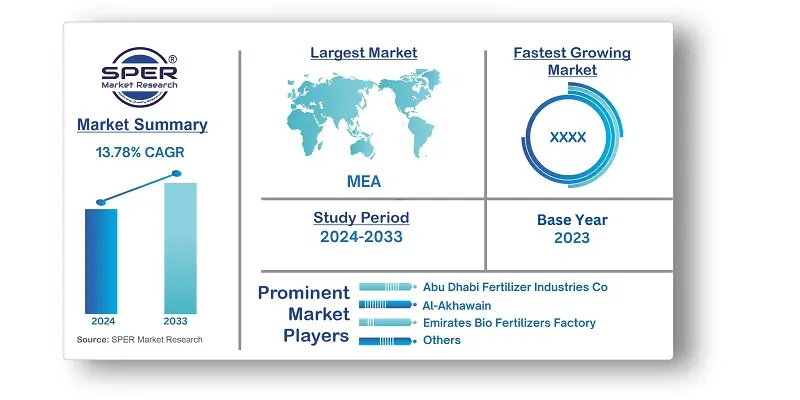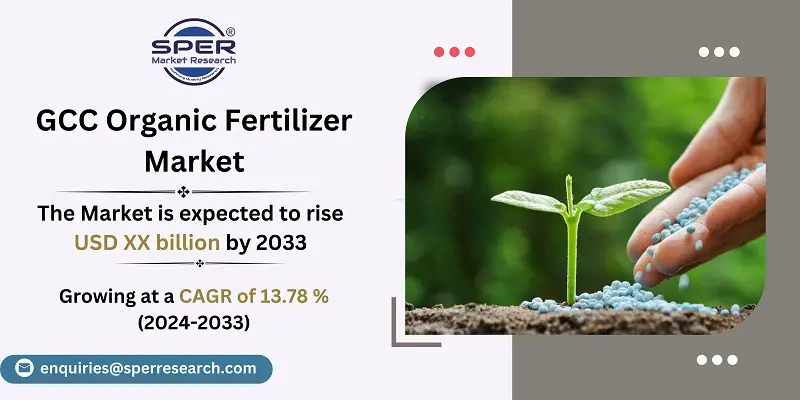
GCC Organic Fertilizer Market Growth, Size, Trends, Demand, Share, Revenue and Future Outlook
GCC Organic Fertilizer Market Size- By Product Group, By Application- Regional Outlook, Competitive Strategies and Segment Forecast to 2033
| Published: Mar-2024 | Report ID: AGRI2410 | Pages: 1 - 157 | Formats*: |
| Category : Agriculture | |||
- In May 2022: the UAE's Minister of Climate Change and Environment officially opened the Circa Biotech waste-to-feed project. This facility raises black soldier fly (BSF) larvae on leftover food and produces animal proteins, organic fertilizers, and oils from the larvae.
- In March 2022: In partnership with Heenat Salma Farm, Qatar has launched two interactive tours, "Discover Organic Farming in the Desert" and "Discover Organic Farming and Sunset at Zeekret," that teach visitors about organic farming in the desert. The tours feature thirty different crop types.


| Report Metric | Details |
| Market size available for years | 2020-2033 |
| Base year considered | 2023 |
| Forecast period | 2024-2033 |
| Segments covered | By Product Group, By Application |
| Regions covered | Saudi Arabia, United Arab Emirates, Qatar, Oman, Bahrain, Rest of GCC |
| Companies Covered | Abu Dhabi Fertilizer Industries Co. WLL, Al Yahar Organic Fertilizers Factory, Al-Akhawain, Arab Qatari Agricultural Production Company, Debbane Saikali Group, Emirates Bio Fertilizers Factory, Heera Organic Fertilizer, International FZCO, Nabat agriculture & Trading Co., Others |
- Agricultural Professionals and Farmers
- Environmentalists and Conservationists
- Government Agencies and Regulatory Bodies
- Sustainable Agriculture Advocates
- Gardening Enthusiasts and Homeowners
- Organic Food Producers
| By Product Group: |
|
| By Application: |
|
| By Region: |
|
- GCC Organic Fertilizer Market Size (FY’2024-FY’2033)
- Overview of GCC Organic Fertilizer Market
- Segmentation of GCC Organic Fertilizer Market By Product Group (Organic Residues, Bio-Fertilizers)
- Segmentation of GCC Organic Fertilizer Market By Application (Grains and Cereals, Pulses and Oilseeds, Fruits and Vegetables, Commercial Crop, Turf and Ornamentals)
- Expansion Analysis of GCC Organic Fertilizer Market
- Problems and Obstacles in GCC Organic Fertilizer Market
- Competitive Landscape in the GCC Organic Fertilizer Market
- Impact of COVID-19 and Demonetization on GCC Organic Fertilizer Market
- Details on Current Investment in GCC Organic Fertilizer Market
- Competitive Analysis of GCC Organic Fertilizer Market
- Prominent Players in the GCC Organic Fertilizer Market
- SWOT Analysis of GCC Organic Fertilizer Market
- GCC Organic Fertilizer Market Future Outlook and Projections (FY’2024-FY’2033)
- Recommendations from Analyst
1.1. Scope of the report1.2. Market segment analysis
2.1. Research data source2.1.1. Secondary Data2.1.2. Primary Data2.1.3. SPER’s internal database2.1.4. Premium insight from KOL’s2.2. Market size estimation2.2.1. Top-down and Bottom-up approach
2.3. Data triangulation
4.1. Driver, Restraint, Opportunity and Challenges analysis
4.1.1. Drivers4.1.2. Restraints4.1.3. Opportunities4.1.4. Challenges4.2. COVID-19 Impacts of the GCC Organic Fertilizer Market
5.1. SWOT Analysis5.1.1. Strengths5.1.2. Weaknesses5.1.3. Opportunities5.1.4. Threats5.2. PESTEL Analysis5.2.1. Political Landscape5.2.2. Economic Landscape5.2.3. Social Landscape5.2.4. Technological Landscape5.2.5. Environmental Landscape5.2.6. Legal Landscape5.3. PORTER’s Five Forces5.3.1. Bargaining power of suppliers5.3.2. Bargaining power of buyers5.3.3. Threat of Substitute5.3.4. Threat of new entrant5.3.5. Competitive rivalry5.4. Heat Map Analysis
6.1. GCC Organic Fertilizer Market Manufacturing Base Distribution, Sales Area, Product Type6.2. Mergers & Acquisitions, Partnerships, Product Launch, and Collaboration in GCC Organic Fertilizer Market
7.1. GCC Organic Fertilizer Market Value Share and Forecast, By Product Group, 2024-20337.2. Organic Residues7.2.1. Farmyard Manure7.2.2. Crop Residues7.2.3. Green Manure7.2.4. Others7.3. Bio-fertilizers7.3.1. Rhizobium7.3.2. Azospirillum7.3.3. Mycorrhizae7.3.4. Others
8.1. GCC Organic Fertilizer Market Value Share and Forecast, By Application, 2024-20338.2. Grains and Cereals8.3. Pulses and Oilseeds8.4. Fruits and Vegetables8.5. Commercial Crop8.6. Turf and Ornamentals
9.1. GCC Organic Fertilizer Market Size and Market Share
10.1. GCC Organic Fertilizer Market Size and Market Share By Product Group (2020-2026)10.2. GCC Organic Fertilizer Market Size and Market Share By Product Group (2027-2033)
11.1. GCC Organic Fertilizer Market Size and Market Share By Application (2020-2026)11.2. GCC Organic Fertilizer Market Size and Market Share By Application (2027-2033)
12.1. GCC Organic Fertilizer Market Size and Market Share By Region (2020-2026)12.2. GCC Organic Fertilizer Market Size and Market Share By Region (2027-2033)12.3. Saudi Arabia12.4. United Arab Emirates12.5. Qatar12.6. Oman12.7. Bahrain12.8. Rest of GCC
13.1. Abu Dhabi Fertilizer Industries Co. WLL13.1.1. Company details13.1.2. Financial outlook13.1.3. Product summary13.1.4. Recent developments13.2. Al Yahar Organic Fertilizers Factory13.2.1. Company details13.2.2. Financial outlook13.2.3. Product summary13.2.4. Recent developments13.3. Al-Akhawain13.3.1. Company details13.3.2. Financial outlook13.3.3. Product summary13.3.4. Recent developments13.4. Arab Qatari Agricultural Production Company13.4.1. Company details13.4.2. Financial outlook13.4.3. Product summary13.4.4. Recent developments13.5. Debbane Saikali Group13.5.1. Company details13.5.2. Financial outlook13.5.3. Product summary13.5.4. Recent developments13.6. Emirates Bio Fertilizers Factory13.6.1. Company details13.6.2. Financial outlook13.6.3. Product summary13.6.4. Recent developments13.7. Heera Organic Fertilizer13.7.1. Company details13.7.2. Financial outlook13.7.3. Product summary13.7.4. Recent developments13.8. International FZCO13.8.1. Company details13.8.2. Financial outlook13.8.3. Product summary13.8.4. Recent developments13.9. Nabat agriculture & Trading Co.13.9.1. Company details13.9.2. Financial outlook13.9.3. Product summary13.9.4. Recent developments13.10. Others
SPER Market Research’s methodology uses great emphasis on primary research to ensure that the market intelligence insights are up to date, reliable and accurate. Primary interviews are done with players involved in each phase of a supply chain to analyze the market forecasting. The secondary research method is used to help you fully understand how the future markets and the spending patterns look likes.
The report is based on in-depth qualitative and quantitative analysis of the Product Market. The quantitative analysis involves the application of various projection and sampling techniques. The qualitative analysis involves primary interviews, surveys, and vendor briefings. The data gathered as a result of these processes are validated through experts opinion. Our research methodology entails an ideal mixture of primary and secondary initiatives.



Frequently Asked Questions About This Report
PLACE AN ORDER
Year End Discount
Sample Report
Pre-Purchase Inquiry
NEED CUSTOMIZATION?
Request CustomizationCALL OR EMAIL US
100% Secure Payment






Related Reports
Our Global Clients
Our data-driven insights have influenced the strategy of 200+ reputed companies across the globe.




















